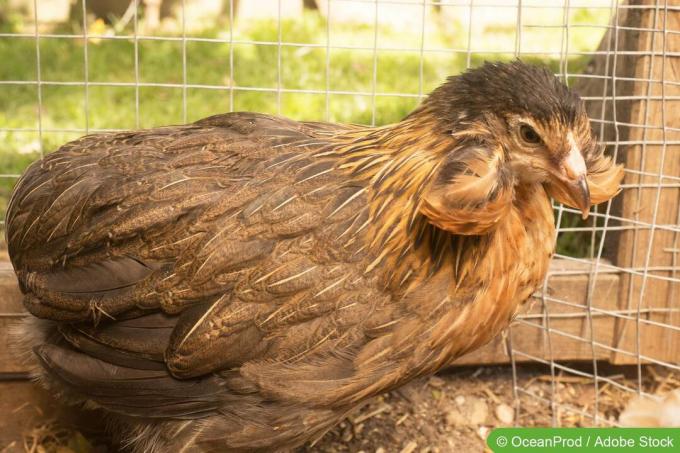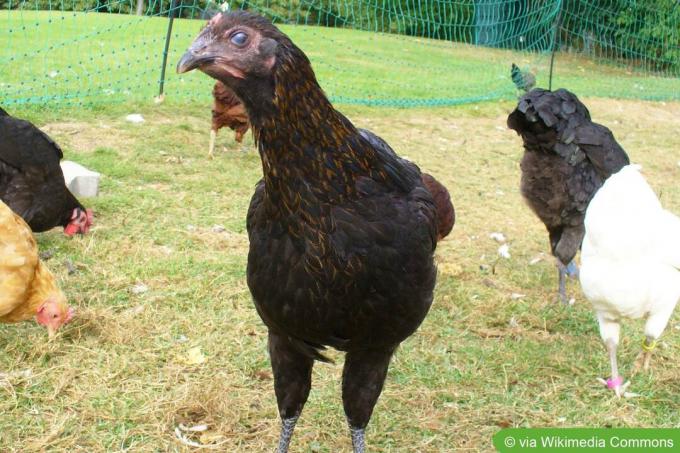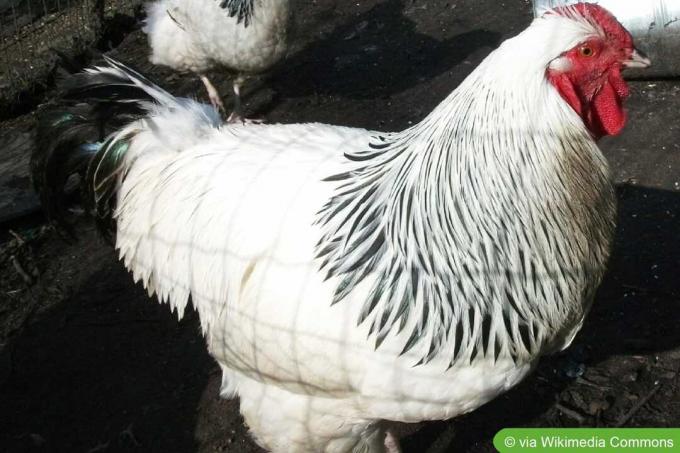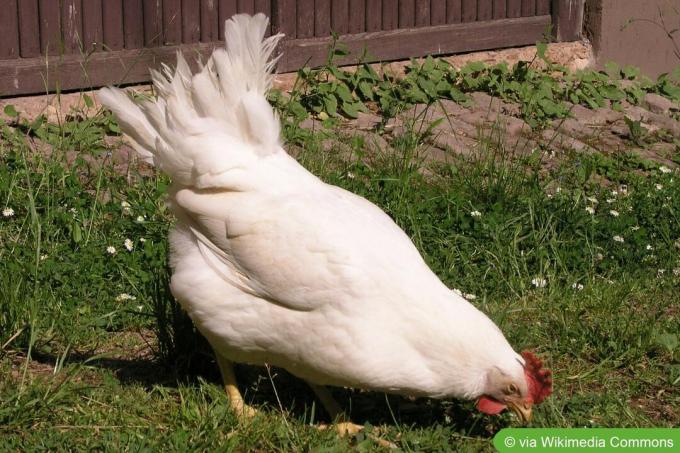

Table of contents
- Layers from A to B
- From C to F
- From H to N
- From O to S
- frequently asked Questions
A laying hen is a domestic female chicken that lays many eggs. As the hobby of keeping chickens in your own garden is becoming more and more popular, but usually only one small numbers of animals can be kept, egg production should not be left to chance become. That is why we present the 23 best breeds of laying hens to you here.
Layers from A to B
amrock

The Amrock chicken is ideal for free-range husbandry, because otherwise it tends to get fat from supplementary feeding.
- Origin: United States
- Appearance: black, white and brown striped
- Character: calm, trusting, easy to tame
- Weight hen: up to 3 kg
- Laying performance per year: up to 220 pieces
- Egg weight: 55 to 65 g
- Egg color: brown
A notice:
Like most of the laying hen breeds presented here, the Amrock is a good dual-purpose breed ("Zwiehen") and is also suitable for slaughter.
Araucana

The Araucana chicken is not sensitive to cold and adapted to harsh climatic regions.
- Origin: Chile
- Appearance: pronounced sideburns and throat beard, multicolored markings, feathers with black accents
- Character: calm, undemanding
- Weight hen: up to 2 kg
- Laying performance per year: up to 180 pieces
- Egg weight: 48 to 52 g
- Egg color: green
Australops

The Australops are beautiful to look at and easy to keep.
- Origin: Australia
- Appearance: strong, black, white, bordered with bluish
- Character: lively, peaceful, trusting
- Weight hen: up to 2.5 kg
- Laying performance per year: up to 260 pieces
- Egg weight: 55 to 65 g
- Egg color: white
Barnevelder chicken

The Barnevelder chicken lays very large eggs, which can sometimes weigh up to 70 grams.
- Origin: Netherlands
- Appearance: noble appearance, black, white, brown-blue or brown-black lined feathers, green-black neck
- Character: good-natured, lively, easy to tame, seeks closeness to people
- Weight hen: up to 2.75 kg
- Laying performance per year: up to 180 pieces
- Egg weight: 63 to 67 g
- Egg color: brown
Bielefeld identification chicken

The Bielefelder Kennhuhn is a relatively young, heavy breed of chickens and is also suitable as a broiler chicken.
- Origin: Germany
- Appearance: barred, brown, black, white
- Character: trusting, calm, easy to tame
- Weight hen: up to 3.25 kg
- Laying performance per year: up to 230 pieces
- Egg weight: 60 to 65 g
- Egg color: white
Brakel

The Brakel chicken is an old breed of chicken whose ancestors probably date back to the 16th century. century go back.
- Origin: Belgium
- Appearance: golden, silver, banded with yellow and white
- Character: bright, scratch a lot, were used in the country of origin as a compost processor
- Weight hen: up to 2.75 kg
- Laying performance per year: up to 180 pieces
- Egg weight: 55 to 60 g
- Egg color: white
Bresse chicken

There are various breeds of Bresse chickens, but the original breed is trademarked.
- Origin: France
- Appearance: bluish legs, white, breeding variants also in other colors
- Character: calm, eager to move
- Weight hen: up to 2.5 kg
- Laying performance per year: up to 240 pieces
- Egg weight: 55 to 65 g
- Egg color: white
From C to F
Croad-Langschan
This laying hen breed is the predecessor of the German Langschan, but is now hardly kept as it has been largely supplanted by German breeding.
- Origin: China
- Appearance: feathered legs, black or white
- Character: active, likes to move, independent
- Weight hen: up to 3.5 kg
- Laying performance per year: up to 200 pieces
- Egg weight: 55 to 65 g
- Egg color: dark brown
German Langschan

The German Langschan is one endangered breed, which, however, can be easily propagated in hobby keeping due to the good breeding instinct.
- Origin: Germany
- Appearance: black or black-brown
- Character: trusting, easy to tame, calm, interested
- Weight hen: up to 3.5 kg
- Laying performance per year: up to 180 pieces
- Egg weight: 55 to 60 g
- Egg color: brown-yellow
German Reichshuhn

This old German breed is an independent forager and should have a large and varied run.
- Origin: Germany
- Appearance: Boxy build, different colors
- Character: trusting, easy to tame, calm
- Weight hen: up to 2.5 kg
- Laying performance per year: up to 200 pieces
- Egg weight: 55 to 60 g
- Egg color: white
German Sparrowhawk

German Sparrowhawks are a popular hobby breed because of their beautiful markings and friendly nature.
- Origin: Germany
- Appearance: Long physique, typical Sparrowhawk markings
- Character hen: trusting, lively
- Weight: up to 2.5 kg
- Laying performance per year: up to 200 pieces
- Egg weight: 55 to 65 g
- Egg color: white
A notice:
Beware of confusion with the "blue sparrow hawks" often offered at small animal markets. This usually refers to hybrid breeds with blue plumage.
dresden

The Dresdner chickens are suitable for husbandry that goes beyond the hobby area, as they are robust but economical.
- Origin: Germany
- Appearance: medium sized, shades of brown
- Character: Lively, trusting, roosters tend to fight for territory
- Weight hen: up to 2.5 kg
- Laying performance per year: up to 180 pieces
- Egg weight: 55 to 60 g
- Egg color: light brown
friesian chicken

Due to the low weight, this small breed of chickens good flight ability and likes to use this to break out of enclosures, which is why keeping it in aviaries is recommended.
- Origin: Netherlands
- Appearance: Multi-colored, common forms are silvery to yellowish flaked
- Character: very active, robust, friendly, always slightly shy
- Weight hen: up to 1.2 kg
- Laying performance per year: up to 160 pieces
- Egg weight: 50 to 54 g
- Egg color: white
From H to N
Hamburger chicken

The Hamburg chicken is ideal for free range because they like to perch in trees or bushes.
- Origin: Germany, Netherlands
- Appearance: seven colors, black with a green sheen, silver-white, silver speckled, lacquered in gold and silver, edged in blue
- Character: shy, robust, likes to move, needs a lot of activity and exercise
- Weight hen: up to 2 kg
- Laying performance per year: up to 160 pieces
- Egg weight: 51 to 55 g
- Egg color: white
A notice:
Keep predators like Fox or marten in the vicinity, you should refrain from spending the night outdoors. Alternatively, you can house the animals in an aviary with a natural design.
Italian

The Italians are very good laying chickens, whose laying performance is high even after a few years.
- Origin: Italy
- Appearance: strong, different colors with some beautiful gradients
- Character: lively, trusting, needs a lot of exercise
- Weight hen: up to 2.5 kg
- Laying performance per year: up to 200 pieces
- Egg weight: 55 to 65 g
- Egg color: white
Kraienkoppe

The Kraienköppe are a breed for experienced chicken keepers who gain the trust of the animals with the necessary sensitivity.
- Origin: Germany
- Appearance: white neck and back, black chest and tail, noticeably small crest
- Character: behavior close to nature, ready to defend, trusting towards familiar people
- Weight hen: up to 3.2 kg
- Laying performance per year: up to 200 pieces
- Egg weight: 53 to 57 g
- Egg color: white
Leghorn chicken

This extremely productive laying hen breed is particularly suitable for beginners, as the animals are very robust and forage a lot in the garden themselves.
- Origin: Italy
- Appearance: white plumage, slender
- Character: lively
- Weight hen: up to 2.2 kg
- Laying performance per year: up to 220 pieces
- Egg weight: 53 to 57 g
- Egg color: white
Lohmann Brown

The Lohmann chicken is a hybrid breed from which no offspring is possible, but has one of the highest laying performances.
- Origin: Germany
- Appearance: Brown, with occasionally lighter tail tips
- Character: trusting, calm, prone to stress
- Weight hen: up to 2 kg
- Laying performance per year: up to 320 pieces
- Egg weight: 60 to 70 g
- Egg color: brown
New Hampshire

The New Hampshire chicken is a good dual purpose breed that is also easily fattened.
- Origin: United States
- Appearance: tricolor, brown ground color with different color nuances, iridescent blue-green tail
- Character: calm, trusting, balanced, easy to tame
- Weight: up to 3 kg
- Laying capacity: up to 250 pieces
- Egg weight: 55-65 g
- Egg color: brown
From O to S
Orpington

The Orpington chicken has a compact, broad body and attractive colors.
- Origin: Great Britain
- Appearance: different colors, partly multicolored with a beautiful color gradient
- Character: calm, trusting, easy to tame
- Weight hen: up to 3.5 kg
- Laying performance per year: up to 180 pieces
- Egg weight: 50 to 60 g
- Egg color: light brown
Plymouth Rock

The Plymouth Rock chicken is the origin of many other breeds of very good performing leg hens.
- Origin: United States
- Appearance: large, strong chest, many color variations, often striped
- Character: lively, trusting
- Weight hen: up to 3 kg
- Laying performance per year: up to 190 pieces
- Egg weight: 55 to 60 g
- Egg color: yellow-brown
Tip:
The hens of this breed are excellent winter layer.
Rhineland chicken
This laying hen breed continues to impress for several years with high egg production.
- Origin: Germany
- Appearance: numerous colors
- Character: very trusting, agile, undemanding
- Weight hen: up to 2.5 kg
- Laying performance per year: up to 180 pieces
- Egg weight: 53 to 57 g
- Egg color: white
sundheimer

The Sundheimer chicken is originally a corpulent broiler chicken, but it also has an excellent laying performance.
- Origin: Germany
- Appearance: white base color, black tail, neck with black spots or all black
- Character: calm, trusting, easy to tame
- Weight hen: up to 2.5 kg
- Laying performance per year: up to 220 pieces
- Egg weight: 55 to 65 g
- Egg color: white
frequently asked Questions
The Leghorn is one of the front runners. In the first year, hens sometimes even manage to lay up to 300 eggs. There are also various laying hybrids that are bred specifically for high laying performance. The disadvantage of these hybrids is that although they lay many eggs, they are not fertile and are not suitable for self-reproduction. In addition, the laying performance of the hybrids decreases sharply after two to three years, which means that they are mainly used for income.
Most chicken breeds, even laying hens, lay little to no eggs in winter. There are so-called winter layers. These are chicken breeds that also lay eggs in winter. However, you shouldn't expect an egg every day either. Winterlayers are, for example, Kraienköppe, Rheinländer or Orpington.
Layers produce the most eggs in their first year. Laying performance is regular up to about the third year of life. After that, the laying performance decreases sharply, which is why most chickens in farms are exchanged after two years. On average, chickens can live up to ten years, sometimes even longer. Depending on the feed and care, chickens can still lay eggs for up to nine years.
 Mirko
Mirko
Learn more about pets

Common chicken diseases with symptoms + pictures
Chickens are low-maintenance animals, but they are not immune to diseases. Parasites, viruses or bacteria can cause them problems and serious illnesses are even notifiable. Here you will find the most common chicken diseases with symptoms and pictures at a glance.

Chicken twists its head: what does that mean?
When chickens suddenly tilt their heads, there is usually a serious reason behind it. Here you can find out what can be responsible and what action should be taken if a chicken turns its head.

Chicken tilts to the side: balance disorder?
Keeping chickens in your own garden is becoming increasingly popular. All you need is enough exercise and a winter-proof stable. Unfortunately, chickens are not the most robust creatures. For example, if a chicken repeatedly falls to the side, it can be due to an imbalance, but it can also be worse.

Bird Names: 348 Popular Budgie Names
If you have budgies as pets or are planning to get two parakeets, the exciting task ahead of you is naming them appropriately. In this text you will be presented with various budgie names to help you choose of a name that suits both your feathered friend and your personal taste fits.

441 guinea pig names from cute to funny
A suitable guinea pig name can not only be a fun or cute addition, but also a way to create a special bond with your little furry friend.

Turtle Names: 473 Names for Turtles
Finding an appropriate name for your turtle can be a fun and meaningful task. A well-chosen turtle name can underline your friend's personality and uniqueness and create a special bond between the two of you. Whether you're looking for male, female, or gender-neutral names, you'll find a wide range of names for your […]



